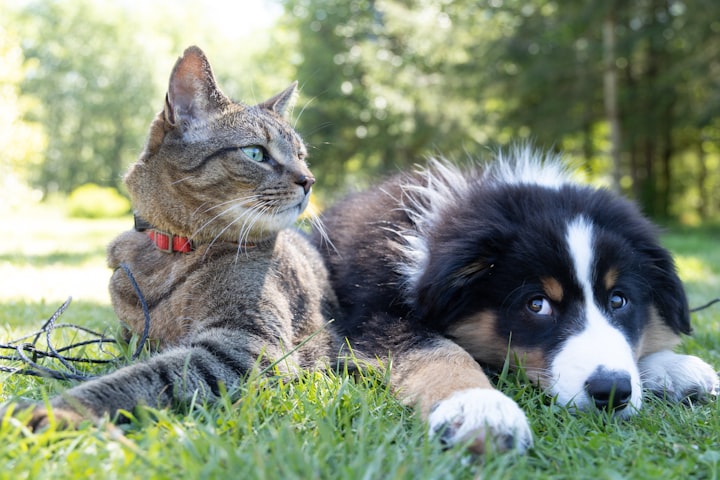Furry Education: Training Tips for Cats and Dogs of all Breeds and Sizes
Lets show some love for our pets !
As pet owners, we all want our furry friends to be well-behaved and obedient. However, training your dogs and cats can often seem like a daunting task. But fear not, because with the right approach and techniques, you can effectively train your four-legged companions of all breeds and sizes. In this blog post, we will provide you with valuable tips and tricks for training your dogs and cats, helping you establish a strong bond and a harmonious relationship with your beloved pets. So let's dive in and learn how to make your furry friends the most well-mannered and well-trained animals in the neighborhood!
Understanding Your Pet's Behavior
Understanding Your Pet's Behavior is key to successful training. Dogs and cats have their own unique personalities and instincts, which greatly influence their behavior. Dogs are pack animals and thrive on social interaction and structure. They may exhibit behaviors like barking, digging, or chewing when bored or anxious. Cats, on the other hand, are more independent and territorial. They may scratch furniture or display aggression if they feel threatened or stressed.
By observing your pet's behavior and understanding their needs, you can tailor your training approach accordingly. Positive reinforcement is vital for both dogs and cats. Rewarding desired behaviors with treats, praise, or playtime can reinforce good behavior and create a positive association.
Additionally, consistency is key when it comes to training schedules. Dogs and cats thrive on routine, so establishing a consistent training schedule helps them understand expectations and develop good habits.
Understanding and addressing behavioral issues is crucial for effective training. Identifying the underlying cause of a behavior problem and using appropriate techniques can help resolve the issue and prevent future occurrences.
By understanding your pet's behavior, using positive reinforcement, establishing a training schedule, and addressing behavioral issues, you can create a strong bond with your furry friend and ensure a well-behaved and happy companion.
Using Positive Reinforcement
Positive reinforcement is a powerful tool when it comes to training your dogs and cats. This approach focuses on rewarding good behavior rather than punishing bad behavior. By rewarding your pets for behaving appropriately, you are encouraging them to repeat those behaviors in the future.
When using positive reinforcement, it's important to choose rewards that your pet finds motivating. This can include treats, praise, or playtime. Each time your pet performs a desired behavior, such as sitting or coming when called, immediately reward them with something they enjoy. This will create a positive association and reinforce the behavior.
Consistency is key with positive reinforcement. Make sure to reward your pet consistently every time they exhibit the desired behavior. This will help them understand what is expected of them and motivate them to continue behaving well.
Positive reinforcement not only helps with training, but it also strengthens the bond between you and your pet. It creates a positive and trusting relationship, making training sessions enjoyable for both of you.
Remember, using positive reinforcement is a gentle and effective way to train your pets. It helps them learn and grow while also fostering a loving and harmonious environment. So be patient, be consistent, and watch your furry friends thrive!
Establishing a Training Schedule
Establishing a consistent training schedule is essential for successfully training your dogs and cats. Dogs and cats thrive on routine and predictability, so having a structured training schedule helps them understand what is expected of them and when.
When creating a training schedule, consider your pet's energy levels and attention span. Dogs typically have more energy and can handle longer training sessions, while cats may prefer shorter, more frequent sessions. Make sure to allocate specific times during the day for training, and stick to those times as closely as possible.
During training sessions, create a quiet and distraction-free environment to help your pet focus. Turn off the TV, put away toys, and ensure there are no other distractions that may interfere with their learning.
Remember to keep training sessions short and enjoyable for your pet. Aim for sessions that are 5-10 minutes long, multiple times a day. This will help keep your pet engaged and prevent them from becoming bored or frustrated.
By establishing a consistent training schedule, you are setting your furry friends up for success and creating a positive learning environment for them.
Dealing with Behavioral Issues
Dealing with behavioral issues can be challenging when training your dogs and cats, but it's important to address them effectively. One common issue is separation anxiety, which can lead to destructive behaviors like chewing or scratching. To help alleviate this, gradually introduce your pet to being alone and provide them with toys or puzzle feeders to keep them occupied.
Aggression is another issue that may arise, especially in cats. If your cat displays aggression towards people or other animals, it's important to consult with a veterinarian or animal behaviorist for guidance. They can help determine the underlying cause and provide strategies to manage the aggression.
Fear and anxiety are also common behavioral issues. Creating a safe and calm environment, using positive reinforcement, and desensitization techniques can help alleviate these issues.
Remember, addressing behavioral issues requires patience and understanding. Seek professional help when needed, and always approach the issue with a compassionate and positive mindset.
If you want to learn more about how i learned all this stuff, i really recommend you reading this book.






Comments
There are no comments for this story
Be the first to respond and start the conversation.